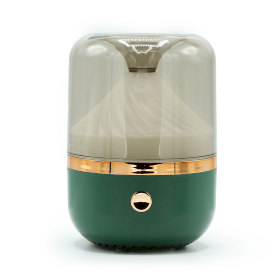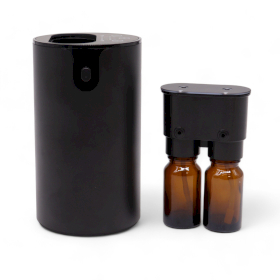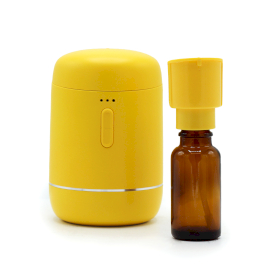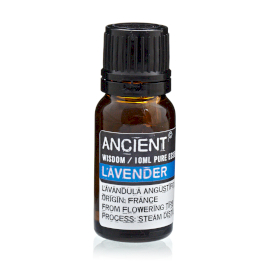Best Electric Diffusers for Home: Ultrasonic vs Nebulizing Diffusers
When it comes to electric essential oil diffusers, the market offers several options, each catering to different needs and preferences. Among the most popular types are ultrasonic diffusers and nebulising diffusers. While both disperse essential oils into the air, they do so in very different ways, leading to unique benefits and drawbacks for each. Understanding these differences can help you choose the best electric diffuser for your home, office, or wellness routine.
What is an Ultrasonic Diffuser?
An ultrasonic diffuser is a type of electric aroma diffuser used to disperse essential oils into the air. It works by using ultrasonic vibrations to create a fine mist of water and essential oils, without using heat. The process involves an ultrasonic plate that vibrates at a very fast rate, breaking down the mixture of water and essential oils into micro-particles which then disperse into the air as a fine mist. This method preserves the integrity of the essential oils, allowing you to benefit fully from their therapeutic properties. Ultrasonic diffusers also act as humidifiers, which can help to improve air quality in dry environments.
Pros:
- Quiet operation: The ultrasonic vibrations are silent.
- Safe: Offers more secutiy when used around children and pets
- Affordable: Typically less expensive than nebulizing diffusers.
- Humidifies the air: Ideal for dry climates or during winter.
- Versatile: Many models come with additional features like LED lights and timers.
Cons:
- Requires water
- May not be suitable for large rooms
- Diluted scent: Since essential oils are mixed with water, the scent can be less potent.
- Less effective for therapeutic use: The dilution means you might not get the full therapeutic benefits of the oils.
Using an Ultrasonic Diffuser:
1. Fill the Water Tank: Start by filling the diffuser's tank with clean, cool water up to the mark specified in the diffuser's instructions. Avoid overfilling to prevent malfunction.
2. Add Essential Oils: Add a few drops of your chosen essential oil into the water. Usually, 3-10 drops, depending on the size of the room and the diffuser's specifications.
3. Close and Turn On: Place the lid back on the diffuser and turn it on. Choose your desired settings for mist output and, if available, light options.
4. Cleaning: Regular cleaning is crucial to maintain the diffuser's functionality and prevent mold buildup. Clean it according to the manufacturer’s instructions, typically involving wiping the ultrasonic plate with a soft cloth and rinsing the tank.
When to Use an Ultrasonic Diffuser
For Smaller Spaces: Ultrasonic diffusers are ideal for smaller rooms or personal spaces because they disperse a gentle mist that is sufficient to scent a limited area without overwhelming the senses.
Humidity Addition: If you want to add moisture to the air in addition to enjoying the aromatherapy benefits, an ultrasonic diffuser is the better choice. It can help combat dry air, particularly in air-conditioned rooms or dry climates.
Energy Efficiency and Safety: Ultrasonic diffusers use water and emit a cool mist, making them safer to use around children and pets. They are also energy efficient as they do not use heat.
Longer Duration: Since ultrasonic diffusers use water to dilute oils, the scent is dispersed more gradually and the diffuser can run longer on a single filling, making it suitable for extended use throughout the day or night.
Explore Some of Our Ultrasonic Diffusers
What is a Nebulizer Diffuser?
A nebulizer diffuser is another type of electric essential oil diffuser that uses an entirely different mechanism to disperse essential oils into the air. Unlike ultrasonic diffusers, nebulizer diffusers do not use water. Instead, they work by using an atomizer to create a fine spray or mist from pure essential oil, which is then expelled into the air. This method can disperse a more concentrated aroma into a larger space more quickly than ultrasonic diffusers. Nebulizers are particularly effective for aromatherapy because they deliver a more potent version of the essential oil’s therapeutic properties directly into the environment.
Pros:
Pure, undiluted scent: Delivers a strong, pure aroma without dilution.
Preserves the therapeutic properties of essential oils: The concentrated mist is
perfect for those using essential oils for aromatherapy.
No water required: Less maintenance compared to ultrasonic diffusers.
Effective for large rooms
Cons:
No humidification: Unlike ultrasonic diffusers, nebulizers do not add moisture to the air.
Louder operation: The internal pump can be noisier than ultrasonic models.
Higher cost: Nebulizing diffusers are typically more expensive.
Oil consumption: They use essential oils more quickly, which can be costly.
Using a Nebulizer Diffuser:
1. Add Essential Oils: Attach a bottle of essential oil to the diffuser (most nebulizers work with standard oil bottles).
2. Assemble and Turn On: Assemble any pieces such as the cap or nozzle, and then turn the device on. Adjust the output settings as necessary for your space.
3. Allow the diffuser to run in intervals: Usually 10-15 minutes at a time, as the concentrated mist can quickly fill a room.
4. Cleaning: Nebulizers require regular cleaning to ensure optimal performance and longevity. Follow the manufacturer’s instructions which may involve using rubbing alcohol to clean the glass reservoir and removing oil residues.
When to Use a Nebulizer
For Larger Spaces: Nebulizers are more powerful and can distribute a more concentrated scent over a larger area. If you need to cover a big space like a living room or an open office, a nebulizer might be more effective.
Maximum Therapeutic Benefits: Since nebulizers use pure essential oils without diluting them with water, they deliver a stronger concentration of therapeutic aromas. This makes them ideal for targeted aromatherapy treatments where a higher intensity of the oil’s properties is beneficial.
Quick Aroma Distribution: If you need to quickly fill a space with a scent, for example, to mask odors or create a specific ambiance for guests or during an event, a nebulizer can achieve this rapidly.
No Humidity: In environments where added humidity is not desired, such as in already damp or mold-prone areas, a nebulizer is preferable as it does not emit moisture.
Explore Our Nebulizing Diffusers
Both types of electric diffusers can greatly enhance your environment, making them a popular choice for those seeking to enjoy the benefits of essential oils in their home or office. When choosing between an ultrasonic diffuser and a nebulizer, consider your specific needs such as the size of the area you wish to use it in, the intensity of the aroma you prefer, and whether you could benefit from added humidity. In summary, consider an ultrasonic diffuser if you’re looking for a safe, efficient, and moisture-adding option for smaller spaces. Opt for a nebulizer if you need powerful aroma coverage without additional humidity, particularly in larger spaces or for more intense therapeutic needs.




















